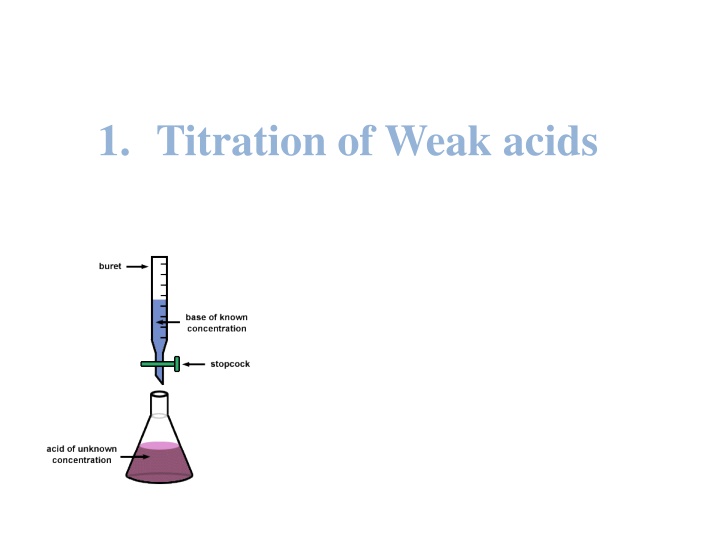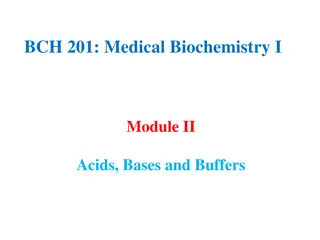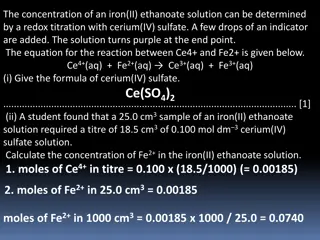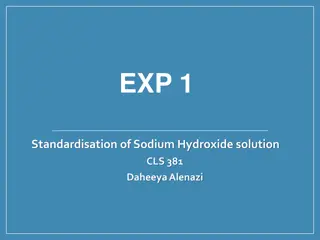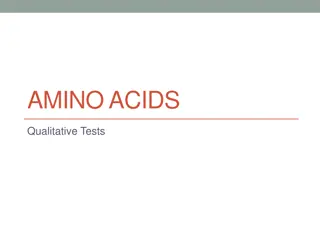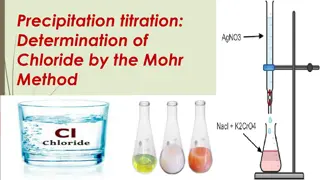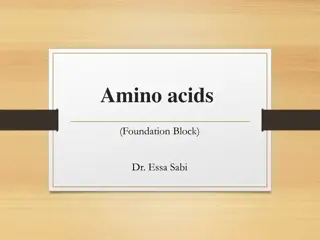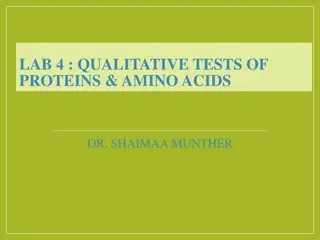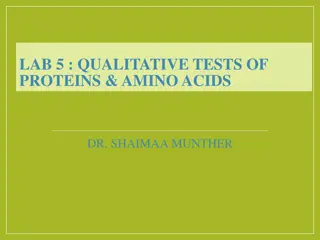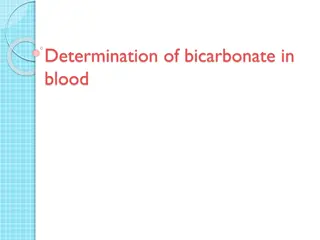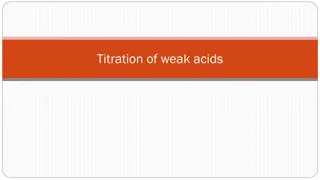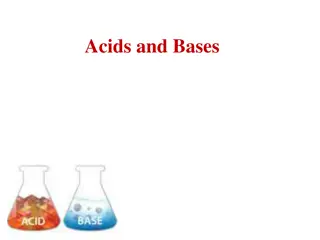Titration of Weak Acids
Titration of weak acids involves the dissociation of weak acids with strong bases, using equilibrium expressions with Ka values. The process disrupts the equilibrium between the weak acid and its ions, leading to neutralization. An example calculation for the titration of a weak acid with a strong base is provided, demonstrating the pH changes during the titration process.
Download Presentation

Please find below an Image/Link to download the presentation.
The content on the website is provided AS IS for your information and personal use only. It may not be sold, licensed, or shared on other websites without obtaining consent from the author.If you encounter any issues during the download, it is possible that the publisher has removed the file from their server.
You are allowed to download the files provided on this website for personal or commercial use, subject to the condition that they are used lawfully. All files are the property of their respective owners.
The content on the website is provided AS IS for your information and personal use only. It may not be sold, licensed, or shared on other websites without obtaining consent from the author.
E N D
Presentation Transcript
Titration of a Weak Acid When a strong acid is titrated with a strong base, the pH at any point is determined by the concentration of un-titrated acid or excess base. When a weak acid is titrated with a strong base, the weak acid dissociates to yield a small amount of H+. Weak acids or bases do not dissociate completely, therefore an equilibrium expression with Ka must be used.
Titration of a Weak Acid Continue HA H++ A- When OH-ions are added H++ OH- H2O The equilibrium between the weak acid and its ions is disrupted. Thus, more HA ionizes and the newly produced H+ ions neutralized by more OH-ions until all of the H+ originally present is neutralized. HA + OH- H2O+ A-
Titration of a Weak Acid Continue Example: Calculate the appropriate values and draw the curve for the titration of 500ml of 0.1M weak acid HA with 0.1M KOH, Ka= 10-5, p Ka= 5 ? A) at the start point: before any addition of any base pH = ( pKa+ p [HA]) pH = ( 5+ 1) pH = 3 B) at any point during the titration: after the addition of 100ml KOH pKa + log [A-] [HA] pH =
Titration of a Weak Acid Continue Since KOH + HA KA + H2O No. of moles of KOH added = M * V = 0.1 * 0.1 = 0.01 mole No. of moles of original HA= M * V = 0.1 * 0.5 = 0.05mole 1 mole of OH- will react with 1 mole of HA to produces 1 mole of salt. Thus, the no. of moles of salt produced = 0.01 mole. No. of moles of remaining HA added=moles of HA originally present moles of HA titrated to salt. = 0.05 0.01 = 0.04 mole pKa + log [A-] [HA] pH =
Titration of a Weak Acid Continue pKa + log [A-] [HA] pH = pH = 5 + log ( 0.01 / 0.04) pH = 4.4 C) at any point during the titration: after the addition of 250ml KOH No. of moles of KOH added = M * V = 0.1 * 0.25 = 0.025 mole No. of moles of original HA= M * V = 0.1 * 0.5 = 0.05mole 1 mole of OH- will react with 1 mole of HA to produces 1 mole of salt. Thus, the no. of moles of salt produced = 0.025 mole. No. of moles of remaining HA added= moles of HA originally present moles of HA titrated to salt. = 0.05 0.025 = 0.025 mole
Titration of a Weak Acid Continue pKa + log [A-] [HA] pH = pH = 5 + log ( 0.025 / 0.025) pH = 5 Here the [A-] = [HA] thus, pH = pKa D) at any point during the titration: after the addition of 375ml KOH No. of moles of KOH added = M * V = 0.1 * 0.375 = 0.0375 mole No. of moles of original HA= M * V = 0.1 * 0.5 = 0.05mole 1 mole of OH- will react with 1 mole of HA to produces 1 mole of salt. Thus, the no. of moles of salt produced = 0.0375 mole. No. of moles of remaining HA added= moles of HA originally present moles of HA titrated to salt. = 0.05 0.0375 = 0.0125 mole
Titration of a Weak Acid Continue pKa + log [A-] [HA] pH = pH = 5 + log ( 0.0375/ 0.0125) pH = 5.48 E) at the end point of the titration: after the addition of 500ml KOH No. of moles of KOH added = M * V = 0.1 * 0.5 = 0.05 mole No. of moles of original HA= M * V = 0.1 * 0.5 = 0.05mole 1 mole of OH- will react with 1 mole of HA to produces 1 mole of salt. Thus, the no. of moles of salt produced = 0.05 mole. The final volume of the solution = 500+500 = 1000ml
Titration of a Weak Acid Continue [A-] = 0.05/1 = 0.05 M p [A-] = -log 0.05 = 1.3 pOH = ( pKb + p [A-]) = ( 9 + 1.3) = 5.15 pH= pKw pOH = 14- 5.15 =8.85
Titration of a Weak Acid Continue From the previous example: A) All HA is in the form of CH3COOH B) [CH3COOH] > [CH3COO-] C) [CH3COOH] = [CH3COO-] D) [CH3COOH] < [CH3COO-] E) All as CH3COO-
Notes: The pH calculated by different way : At starting point pH= (pKa+p[HA]) /2 At any point within the curve (after , in or after middle titration) pH=pKa+ log[A-]/[HA] At end point pOH=(pKb+p[A-]) /2 pH=pKw pOH
